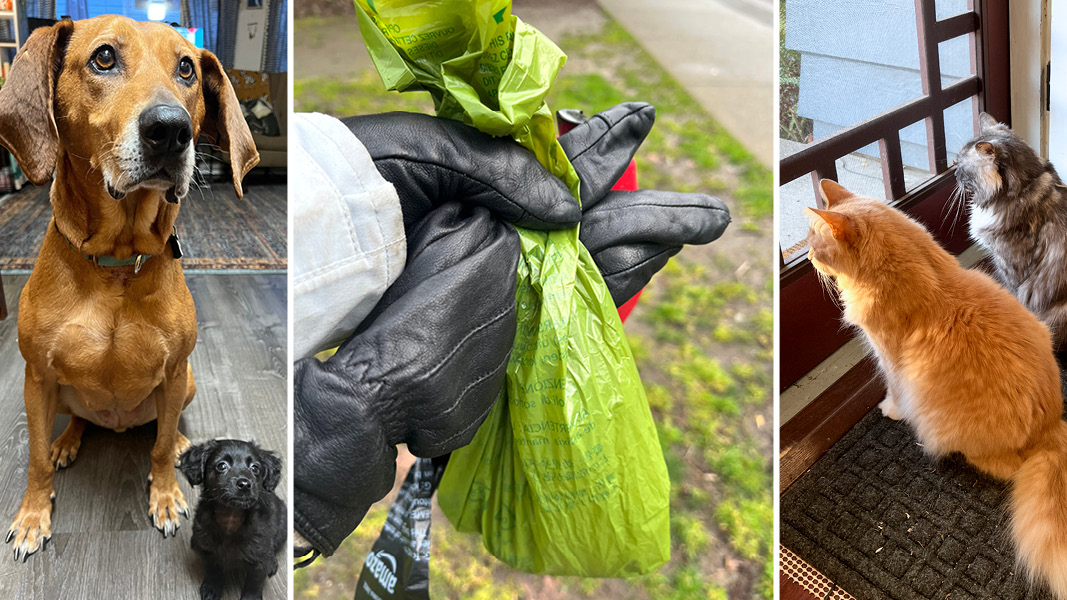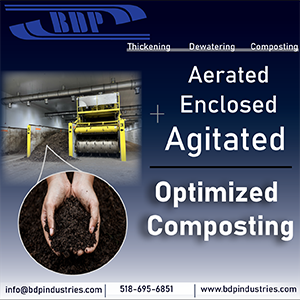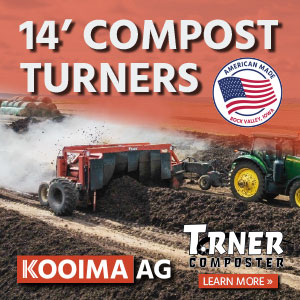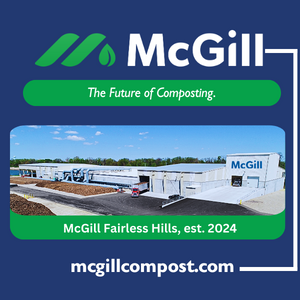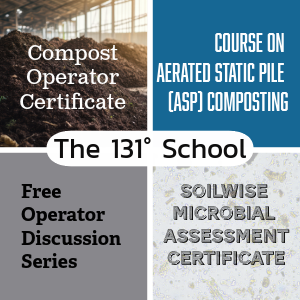Top: In most source separated organics programs, waste from dogs and cats are not considered an acceptable feedstock for composting. Photos by Sally Brown
 Sally Brown
Sally Brown
Could man’s best friend be the next big opportunity for compost? As of 2024, best friends in the U.S. numbered 89.7 million dogs and 73.8 million cats. About 45% of all households are greeted by wagging tails when they get home with another 32% having felines that may or may not deign to look up when you arrive (AVMA). Whichever type of companion you choose, they will poop. For dogs, it’s an average of 340 g/day, with cats producing 136 g/day (Zhang et al., 2019). That comes to 11.1 million tons of dog poop and 3.7 million tons of cat poop annually. Likely those are wet weight measures but nevertheless, a significant quantity of feedstock.
And where does it go? In my very green city of Seattle, we are explicitly instructed to leave that poop out of the green bin. Instead put it in a plastic bag — no need to bother with compostable — and put it in the trash. (The city notes that conditions in the landfill don’t encourage the breakdown of compostables.) It does recommend making sure you let the air out of the bag before putting it in the trash to prevent formation of a “dog waste balloon” that could burst in the can or truck. Flush some of the poop if you are really passionate about it is the best Seattle can do in greening this waste stream. Burying the waste is not recommended as it can contain pathogens.
Seattle’s recommendations for cat poop are no better. Don’t even think about flushing cat waste or putting cat waste and spent litter in your green bin even if it claims to be compostable. These recommendations or rather the general aversion to pet poop are common. No one appears to be welcoming Fido’s feces with open arms. Why the aversion?
Pet Feces Primer
An early paper referred to dog feces as “a public health and environmental problem” (Marron et al., 1974). The authors noted that dog feces can be a breeding ground for flies and that the feces contain pathogens, including salmonella, leptospirosis, brucellosis, and toxoplasmosis among others. More recent papers have also noted the presence of pathogens in dog poop. A study from South Korea sampled feces from stray and pet dogs (Liyanagana et al., 2004). While pathogens were found in the feces of both categories of dogs, they tended to be higher with the strays. The pathogens included some familiar names such as Giardia, Helicobacter and Campylobacter. Worms are also common. If your dog is anything like mine, this comes as no surprise. Some of her favorite street foods include goose poop and horse manure. Rotten fish is also high up there. It should be noted that each of these treats can also double as a skin treatment — as is evidenced by her desire to roll in them — but I digress.

Dog and cat feces also contain PFAS and microplastics as these pollutants live in our homes and often on our furniture.
Dog and cat feces also contain microplastics and PFAS (Ma et al., 2020; Zhang et al., 2019). These pollutants live in our homes. Often on our furniture. If the couch is off limits, then certainly on carpets and dog beds. I would guess that many dog owners are like me and opt for the pet resistant carpet when visions of dog diarrhea come to mind. Pet resistant is code for “contains PFAS.” The various chew toys and other objects that become chew toys likely contain plastics. While the presence of plastics and PFAS in animal feces may come as a surprise, I would take that as a reason to feel an even stronger bond with your pet rather than as an excuse to landfill their wastes. We share our homes with our pets, the corollary to that being that we also share our contaminants. If we ever manage to get plastics and PFAS out of our homes, they will likely decrease in our animals.
Pathogens are a concern in human waste and can also be found in food scraps. That is why composting often require piles to reach time and temperature to be pathogen free. The environment in dog and cat intestines are not dissimilar to our own — warm and wet and largely anaerobic. The presence of anaerobic bacteria in dog intestines is clear to anyone who has ever sat downwind of a dog after a particularly yummy forage into the garbage. Even without reaching temperature, adequate time in an aerobic environment should be sufficient to reach pathogen kill.
Bryson et al. (2024) wrote a review paper about composting dog poop at home. It ended up being a very general paper as there were few studies to review. The authors note that some home systems involve digging a hole in the soil and putting the poop in the hole. This is also something I found on Reddit. Reading about the method, it seems to have a high potential for anaerobic conditions and methane release. Worms and black soldier flies were other options mentioned by the authors but not easily adaptable to backyard settings. The plastic bag issue also makes this option a challenge. As has been covered in BioCycle on multiple occasions, compostable plastic has a much higher chance of actually composting if it is in a commercial facility and not your backyard bin.
A Potential Feedstock Goldmine?
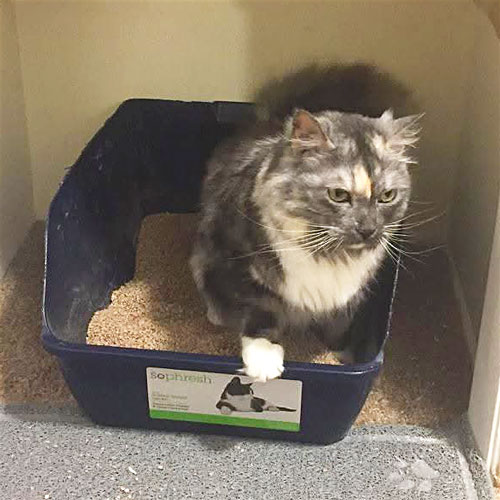
Municipal green bins that accept mixed food and yard waste could easily accept cat waste, especially compostable kitty litter that will provide an extra dose of nitrogen from the pee.
The big opportunities with domestic pet feces appear to be municipal green bins and specialized programs in dog parks. Municipal green bins that accept mixed food and yard waste could easily also accept dog and cat waste. Cat waste is easy. Because your kitty has a litter box that serves as a receptacle for numbers 1 and 2, putting compostable spent cat litter in a bin will have an extra dose of nitrogen (from the pee). A quick search showed that there are numerous compostable brands out there. Cat litter is self-contained and requires disposal when used. This should be a no brainer. Seattle and other municipalities could expand their acceptable feedstocks to include cat poop and spent litter.
Dog poop is more of a challenge. Some dogs do their business in the backyard. That presents the easiest case. Unless you live on large acreage, there is a high possibility that you collect those droppings on a regular basis. Walking around with a shovel or a pooper scooper means that you can put that poop directly into the green bin. No plastic bag required, no potential for contamination. If you are feeding your home compost bin with dog poop that has already partially weathered in the great outdoors (i.e., shoveling up the weekly deposits), it is likely that at least a portion of the pathogens have already met their end. The more time out in the open, the likelier that this will be the case. If you give the compost plenty of time, there is an excellent chance that pathogens will be a distant memory. If you are one of the lucky few to have a home food device like a Lomi or a Mill, you can add dog poop to that. I know that this is true from personal experience. Mill reaches temperature for pathogen kill. I would not feed those grinds to the neighbor’s chickens but have added them to our garden soil. What I am saying here is personal guidance. Note: You will almost certainly not find the same recommendations on a device’s website.
Not all dogs have the luxury of backyard sanitation. Many do their business on a leash while the world watches. That means that there has to be a way to pick up the poop and the plastic bag is the preferred tool. On my dog walks, I am always looking for a garbage bin to dispose the plastic poop bag. I would be much happier to put it into a green bin and would even splurge on compostable poop bags (if they were guaranteed to hold firm and secure). However, the number of people who might do so and not pay attention to the compostability of the poop bag suggests a high potential for more contamination to sort through, already a huge issue at compost facilities.
Dog parks are a much easier sell. Not only can they be a great place for socialization and exercise, they offer a centralized area for poop collection. I found multiple dog parks with pilot programs for collection and composting of poop in a quick, cursory search. Most dog parks provide compostable plastic bags. Dog parks may not be the way to collect and compost the most dog poop but are an excellent gateway to broader understanding and acceptance of poop composting. Plus, they are a great way to make your dog happy and tired. And a tired dog is a good dog.
The take home here is that pet poop (and pee for felines) is a large volume, compostable feedstock that is typically sent to landfills. The path to collection and composting is not necessarily easy or quick. That should come as no surprise but also not as an insurmountable obstacle. Behavior can change. People can learn. Just ask an old dog if they have any new tricks.
Sally Brown, BioCycle Senior Advisor, is a Research Professor at the University of Washington in the College of the Environment.


